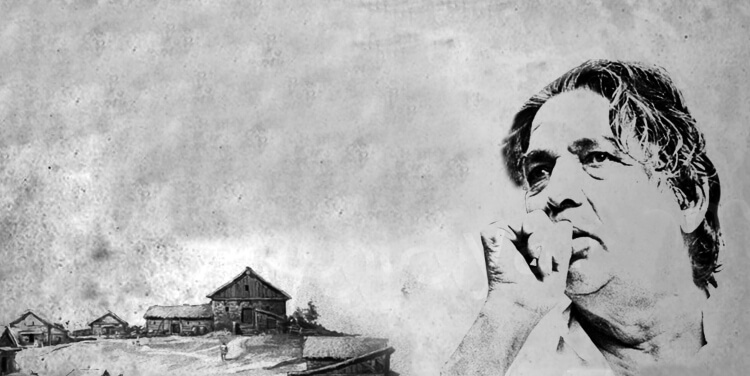If you were not there, what would there be
If you were not there, this planet would still have
Gods and demons, slaves and chieftains
Virtuous ones and winebibbers, pathfinders and robbers
Brahmins, Sheikhs, Priests, Monks
All would have been there but for us
Who would have gladly mounted on the cross
— from “Ibn-e-Maryam”, Kaifi Azmi
Indian artists have long been fascinated with the crucified Christ. Nandalal Bose, Jamini Roy, M. F. Hussain and Krishna Khanna, among others, have all found inspiration meditating on the figure of that stooping, defaced and bleeding cross bearer. They have all reconstructed afresh for our age the most familiar symbol of inexplicable suffering, the iconic illustration of impossible forgiveness, the most fertile metaphor of human redemption.
Among literary representations, one that particularly stands out is a poem by one of India’s foremost Urdu poets, Kaifi Azmi (1919–2002). This year falls the birth centenary of the great poet and much has been written and discussed about him—his prodigious talent that brought him into limelight at the tender age of eleven; his preparations to be a maulvi; his encounter with Communist movement; his arrival from a small village in Azamgarh to Mumbai; his tryst with Bombay film industry; his marriage; his children. It’s all very riveting. Riveting also is his poem about the crucified Christ.
Jesus is a revered prophet among the Muslims and receives highest of respect. Mirza Ghalib (1797–1869), arguably the greatest of Urdu poets, has some memorable couplets about Jesus. But what gave birth to this particular nazm is the statue of Christ that Kaifi Azmi had seen outside a Catholic church in Bombay. His Islam tempered with Communist concerns for the proletariat, gave him a fresh perspective into the Christian interpretation of Jesus. Jesus, who had told the weak and weary of the world to bring their burdens to him, has drawn the attention of this people’s poet who wish to see a more just and equitable world.
In his Urdu poem “Ibn-e-Maryam”, Kaifi Azmi presents a multi-layered psychological response of a modern Indian man to the figure of Jesus.
In this Urdu poem “Ibn-e-Maryam”, Kaifi Azmi presents a multi-layered psychological response of a modern Indian man to the figure of Jesus. He begins by admitting that there are many interpretations of Jesus: God, Son of God, a prophet of peace, or a beautiful imagination. But the poet finds him likeable, he finds him truthful. Jesus is truthful because in a world overpopulated with religious figures and spiritual leaders, it is him and him alone “who gladly mounted on the cross”, proving that his promises are not cheap, expendable words.
The next part of his poem is a reflection on the state of Indian society, the microcosm of which is seen in the settlement of fishermen on the Bombay coast. Fish drying in the sun, cats sitting at a distance waiting for their chance, and listless dogs, who let alone bite don’t even bark—all form a dense portrayal of demoralisation spread among the India’s working class. In and around this settlement, crime is the only activity that flourishes. In an ironic move, the poet says that Jesus is not needed here because there is no danger of injustice here—the criminals who smuggle narcotics in the dead of the night distribute the spoils fairly. The lambs of Jesus, the poet notes, have learned to live peaceably with the wolves.
The tone of the poem becomes more critical of this Jesus ossified by his followers. As a statue, he seems to have been cast in a mode of perpetual waiting. And while he waits, the common man suffers. The farmer is being sold and bought as part of the land itself, the factory worker is being thrown in as a fuel for the gigantic industrial machine. The perennially homeless ordinary man seeks place to rest. He says to the statue of Jesus:
Tonight, you must move out of here
So I could sleep on this plinth where your statue stands
This incapacitated Jesus imprisoned in the church must awaken—this is the poem’s call. The last stanza of the poem, which is at once sarcastic and supplicatory, asks Jesus to rush to the jungles of Vietnam, where the entire villages have been crucified by the Gospel-readers. The crucified villages are calling out to the saviour. The saviour, once again, has to atone for the sins of mankind; he would again have to make the supreme self-sacrifice and mount the cross again
The poet cannot just shake off this image of the suffering messiah out of his mind. He knows from experience that redemption is not possible without going through the dark alleys of disappointments, dangers and occasional defeats. But he also knows that this suffering messiah is also the symbol of ultimate moral victory, because he did not surrender to the whims and pressures of the powerful but remained true to his convictions. Somewhere, this poem is also a challenge thrown to the followers of Christ to make our world more just and humane. Many differences, some irreconcilable, exist between the Communists and the Christians but they both agree that the meek indeed shall inherit the earth.






